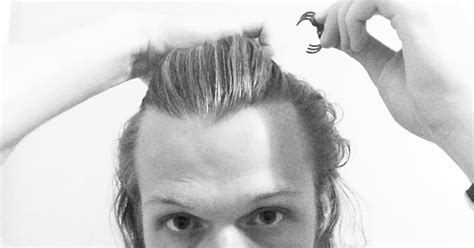1. Introduction

Hair clipping is an essential grooming practice for men. It can enhance their appearance, boost their confidence, and improve their overall well-being. According to the American Hair Loss Association, over 50% of men will experience significant hair loss by the time they reach the age of 50. Hair clipping can help men manage their hair loss discreetly and effectively.
2. Types of Hair Clippers
There are various types of hair clippers available, each with its own unique features and benefits:
- Corded Clippers: These clippers provide consistent power and precision, making them ideal for barbershops and salons.
- Cordless Clippers: These clippers offer portability and convenience, suitable for home use and travel.
- Rotary Clippers: Rotary clippers are known for their speed and efficiency, making them popular among professional barbers.
- Pivot Clippers: Pivot clippers provide maximum maneuverability, allowing for precise cutting in hard-to-reach areas.
3. Selecting the Right Hair Clipper
Choosing the right hair clipper depends on individual needs and preferences. Consider the following factors:
- Hair Type: Coarse or thick hair requires a clipper with a powerful motor and sharp blades.
- Frequency of Use: Frequent use calls for a durable clipper designed for heavy-duty applications.
- Ease of Use: Look for a clipper with an ergonomic design and intuitive controls for effortless handling.
- Budget: Determine a realistic budget and research various options within that range.
4. Hair Clipping Techniques
Mastering proper hair clipping techniques is crucial to achieve desired results. Follow these steps:
a. Wash and Dry Hair
Thoroughly wash and dry your hair before clipping. This removes any buildup or dirt that can clog the blades.
b. Choose the Right Guard
Select the appropriate guard length for your desired hair length. Different guards create varying lengths, from close cuts to longer styles.
c. Comb and Divide Hair
Comb your hair to remove tangles and divide it into sections. Start with the back and work your way forward.
d. Hold the Clipper Correctly
Hold the clipper parallel to the scalp and move it in the direction of hair growth. Keep the blades flat against the skin for an even cut.
e. Trim Gradually
Begin with a longer guard length and gradually decrease it as needed. This helps avoid overcutting and ensures a smooth, natural look.
5. Maintenance and Care
Proper maintenance ensures optimal performance and longevity of hair clippers. Follow these tips:
- Clean Blades: Regularly clean the blades with a brush or alcohol wipes to remove hair and debris.
- Oil the Blades: Apply clipper oil to the blades to lubricate them and prevent friction.
- Store Properly: Store the clippers in a dry place to prevent rust and damage.
- Inspect Regularly: Check the blades for sharpness and replace them if necessary.
6. Safety Precautions
Observe these safety precautions during hair clipping:
- Use Sharp Blades: Dull blades can pull or cut hair, causing discomfort.
- Avoid Overheating: Stop using the clipper if it becomes too hot to prevent skin burns.
- Keep Away from Water: Do not use clippers near water sources to avoid electrical accidents.
- Cut Slowly and Carefully: Avoid rushing the process to prevent injuries or uneven cuts.
7. Conclusion
Hair clipping for men is a simple yet effective way to maintain a well-groomed appearance. By choosing the right clipper, following proper techniques, and observing safety precautions, men can achieve their desired hair length and style. With regular maintenance and care, hair clippers can last for years, providing a reliable and convenient grooming tool.
Additional Tips and Tricks:
- Use a mirror: Position a mirror behind you to monitor your progress and ensure even clipping.
- Clipper over comb: Hold the clipper over a comb to create longer, blended styles.
- Taper Fade: Use a combination of different guard lengths to create a gradual transition from shorter to longer hair.
- Experiment with attachments: Explore various attachments, such as texturizing combs, to add volume or texture to your hair.
Comparison Table:
| Criteria | Rotary Clippers | Pivot Clippers | Corded Clippers | Cordless Clippers |
|---|---|---|---|---|
| Speed | Fast | Moderate | Fast | Slow |
| Efficiency | High | Moderate | High | Low |
| Maneuverability | Low | High | Low | High |
| Durability | High | Moderate | High | Low |
| Cost | High | Moderate | High | Low |
Pros and Cons Table:
| Type | Pros | Cons |
|---|---|---|
| Rotary | – Fast and efficient | – Expensive |
| Pivot | – High maneuverability | – Less durable than rotary clippers |
| Corded | – Consistent power and precision | – Limited mobility |
| Cordless | – Portable and convenient | – Less powerful than corded clippers |
Frequently Asked Questions:
- How often should I clip my hair? The frequency of hair clipping depends on individual hair growth rate and desired style. As a general guideline, aim to clip your hair every 2-4 weeks.
- What is the best clipper blade for thick hair? A clipper blade with high-quality titanium or ceramic blades is recommended for cutting thick hair effectively.
- Can I use hair clippers to shave my beard? While some hair clippers are designed for beard trimming, it is best to use a dedicated beard trimmer for optimal results and to avoid skin irritation.
- How do I avoid clipper burns? Avoid overusing the clippers or applying too much pressure. Regularly cleaning and oiling the blades helps prevent friction and overheating.
- What is the best way to store hair clippers? Store hair clippers in a dry place, away from water sources. Avoid exposing them to extreme temperatures or direct sunlight.
Authoritative Sources:
- American Hair Loss Association: https://www.americanhairloss.org/
- International Association of Hairdressers: https://www.intercoiffure.org/
